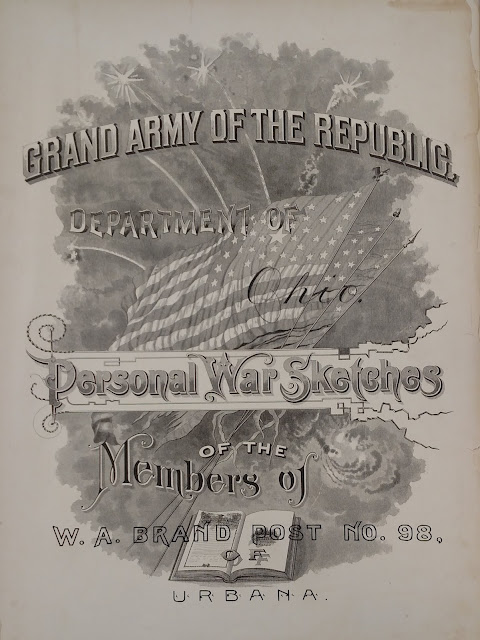Indexing the Urbana Citizen & Gazette
I
recently completed one of my most gratifying indexing projects in tackling the Urbana Citizen & Gazette. This
newspaper, the Republican organ of Champaign County edited by Joshua Saxton,
proved to be one of the best newspapers in the state for its frequent
publication of soldiers’ correspondence. The Champaign County Public Library
recently made available its issues of the C&G
online in a format similar to one used on Chronicling America; while the scans
in some cases are not nearly as crisp as what I’ve grown used to on Chronicling
America, they were mostly clear enough to transcribe and the sheer expanse of
issues available (the entire Civil War period is available online) makes this
resource a tremendous boon for devotees of soldiers’ correspondence.
Champaign
County had a total of three newspapers titles during the Civil War era: the
Republican Urbana Citizen & Gazette,
the Democratic-leaning Urbana Union,
and the Urbana Free Press which ran
through early 1862. As I had previously
indexed the Urbana Union several
years ago (see Columbian Arsenal Press research page here: https://columbianarsenal.com/newspaper-indexes),
this only leaves the Free Press which
is available on microfilm in the Local History room of the Champaign County
Public Library in Urbana. Another project for another time…
As
to the C&G, all I can say is WOW.
I have traditionally held the Western
Reserve Chronicle of Warren, Ohio as the gold standard for newspapers
featuring soldiers’ letters, as it featured 484 letters from April 1861 through
December 1864 when online issues ended. The C&G
takes the crown coming in at 559 letters from April 1861 through May 1865- which
makes it the gold standard by which subsequent Ohio papers can be judged.
Joshua
Saxton encouraged correspondents to write to the newspaper and in some issues
nearly an entire page was devoted to their missives. This Champaign County paper
featured a nice variety of regular correspondents (William A. Brand of the 66th
Ohio had 82 letters, these letters are being published in my forthcoming Army Life According to Arbaw due out in
March), George B. Hunter of the 2nd Ohio Infantry managed to write
24 letters in between his many battle wounds, Francis McAdams of the 113th
Ohio had 25 letters) and occasional correspondents from out of state units such
as the 2nd Iowa, 54th Massachusetts, and the 17th
Michigan Infantry. One real surprise was a serial entitled “Things I have Seen:
Reminiscences of the 2nd Horse in North Carolina” which features a
lengthy journal account from Lieutenant E. Prentiss Tucker of Co. E, 2nd
North Carolina Cavalry (C.S.A.)- yes that is correct, an 11-part serial
published in late 1863-early 1864 from a captured Confederate in a small-town
Ohio paper.
 |
| Colonel Charles Candy, 66th O.V.I. |
The
Ohio units that appear most frequently include the 66th Ohio (174
letters), the 2nd Ohio Infantry (54 letters), the 32nd
Ohio (46 letters, most of them from a correspondent named Seneachie who will be
featured in a future book I’m working on), the 113th Ohio (42
letters), the 26th Ohio (33 letters), the 95th Ohio (26
letters), and 38 from the 134th Ohio, a 100-days regiment. Add a
smattering of letters from the 42nd Ohio, 86th Ohio, the
3rd and 12th Ohio Cavalry regiments, a few from the Navy,
a couple from the 27th U.S.C.T., and even one from a clerk in the
War Department describing the chaos in the army following defeat at Second Bull
Run, and you can see that this one spectacular collection of letters.
As
the focus of this blog has so often been on battle accounts, it is worth noting
that this batch of letters read like a virtual blow-by-blow of the hardest
fought engagements in the war: First Bull
Run, Wilson’s Creek, Carnifex Ferry, First Kernstown, Shiloh, McDowell, Cross
Keys, Port Republic, Cedar Mountain,
Richmond (KY), Second Bull Run, Antietam, Harper’s Ferry, Corinth, Perryville,
Prairie Grove, Dumfries, Stones River, Chancellorsville, Vicksburg, Gettysburg,
Battery Wagner, Chickamauga, Chattanooga, Ringgold, the Overland Campaign, the
Atlanta campaign, Brice’s Crossroads, Kennesaw Mountain, Peach Tree Creek,
Atlanta, and Petersburg.
One
more gem that will be featured in an upcoming blog concerns the surrender at
Appomattox- in this previously hitherto lost account we hear from the
commissary captain (Joseph Carter Brand of Urbana) who at Appomattox was charged
with distributing the 25,000 rations that Grant famously offered to Lee upon
the conclusion of their signing the surrender agreement. This act began the
national healing after four years of bitter strife, and an Urbana man who had
operated a ‘stop’ on the Underground Railroad and had been tried in connection
with the famous 1857 Greene County Rescue case (see blog post here: https://dan-masters-civil-war.blogspot.com/2018/09/willing-to-whip-his-weight-in-wildcats.html)
was intimately connected with it…
All
in all, this index has taken longer than nearly any other that I have done but
the results proved well worth the effort and this truly was a labor of love.
Utilized in conjunction with the Urbana
Union, it provides a tremendous insight into the Civil War experiences of
Champaign County and for Ohio in general. Enjoy!
A link to the index can
be found on my research page at Columbian Arsenal Press: https://columbianarsenal.com/newspaper-indexes
To access issues of the
Urbana Citizen & Gazette, please visit the Champaign County Library website
at: http://champaigncounty.advantage-preservation.com/












Comments
Post a Comment